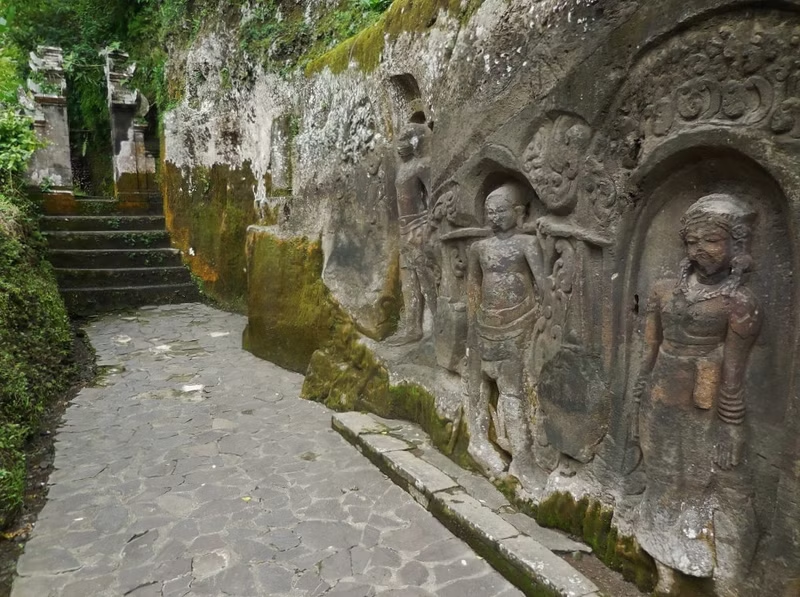Yeh Pulu - Water of the Stone Jar
- Shannon
- Sep 16
- 3 min read
Buried in Time - The Rediscovery of Yeh Pulu’s Ancient Stone Mural
Hidden in a lonely ravine between the Petanu and Pakrisan Rivers, the ruins of this unique 14th-century rock relief lay buried for centuries under volcanic eruptions and vegetation. The site was excavated by Dutch authorities in 1925 and in 1949, a stone gutter was cemented on top in order to drain off water, to prevent erosion and vegetation from taking hold, revealing even more of the stone mural.

Yeh Pulu – Water of the Stone Jar takes its name from a nearby stone vessel believed to hold sacred water
Considered one of the most remarkable and mysterious creations of the Middle Balinese Period, this sprawling 25 metre long life sized frieze is believed to be the work of a lone sculptor and deviates radically from other ancient carvings found in Java or Bali. Its difference in both style and execution points not only to extraordinary technical skill but also to an intensely personal artistic vision, one that continues to intrigue and challenge archaeologists to this day.
Although crudely chiselled, the 700 year old carvings are remarkably well preserved for their age and its survival is largely thanks to having been buried under volcanic ash and jungle for centuries. Now exposed, the frieze unfolds in a deliberate sequence from left to right (or north to south), the scenes alternate between imaginative folktales and finely observed moments of village life. It provides a rare glimpse into the cultural mindset and everyday experiences of 14th-century Bali.
At the southern end of the wall lies a hermit’s dwelling, an austere chamber nearly 7 metres long and 2 metres deep. This modest space would have served as the quarters for an ascetic, a spiritual practitioner who renounces worldly pleasures, through self-discipline and self-imposed poverty in pursuit of enlightenment. These ascetics likely acted as guardians of the site, guiding pilgrims in their offerings and maintaining the sanctity of the space, much like the caretakers who tend it today. In solitude, the ascetic would have spent long hours in meditation and ritual, communing with local gods and ancestral spirits believed to inhabit the surrounding landscape.

Often referred to as “The Land Between the Rivers,” this narrow, 10km stretch of Balinese highland is densely packed with ancient archaeological treasures, including the royal tombs at Gunung Kawi, the Elephant Cave hermitage and the colossal "Moon of Pejeng" bronze drum. Parallels in the depiction of the elephant-headed god Ganesha at both Goa Gajah and Yeh Pulu suggests a close historical relationship between the two sites, possibly rooted in esoteric sects now long since vanished. Myth credits these works to the 14th-century giant Kebo Iwo, a legendary figure said to possess immense strength and sorcery. More than just a builder, Kebo Iwo is remembered in stories as both protector and destroyer, capable of raising temples from stone and leveling kingdoms in rage.
The only deity that is directly represented is this two armed Ganesha, the elephant headed son of Shiva
🗺️ Location
Jalan Yeh Pulu Blahbatuh, Bedulu Village, Blahbatuh District, Gianyar Regency, Bali, Indonesia
🚆 How to get there
This unique archaelogical site is open daily between 7am - 6pm. The entry fee is 15,000 IDR for adults and 7,500 IDR for children. There is also a small 4,000 IDR parking fee. The carved wall is an easy, shaded 300 metre walk from the gate and a Pemangku (a Hindu priest) may ask for a small donation in exchange for a blessing with holy water.
⭐ Attraction Info
This unique site is located about half an hour southwest of Ubud, hidden on the edge of a small farming village called Bedulu. You will definitely need a local guide to find this place. A visit here can be bundled into a half day trip to see other temples and waterfalls in the surrounding areas. You can negotiate a Go-Gek rider for about 250,000 IDR for 4 - 5 hours. Thankfully Yeh Pulu remains off the radar of most tourists for now, so you'll probably have the place to yourself.


















